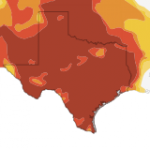Why Climate Change May Increase Water Demands
Climate change has entered the discussion on water availability once again. “The same amount of water won’t go as far as it used to,” says John Nielsen-Gammon, the Texas State Climatologist at Texas A&M University. Nielsen-Gammon shed some light on the relationship between climate change and water availability at the 2012 Texas Water Summit held by the University of Texas at Austin’s Academy of Medicine, Engineering and Science last week.
Nielsen-Gammon and a team of researchers have built climate change models using data derived from the short term climate fluctuations known as La Niña. “We can use short-term issues as a window to understanding what we have to deal with in the long-term,” he says.
While a La Niña year may be predicted several months in advance, long-term climate fluctuation is a tougher nut to crack. Many factors feed long-term climate change, Nielsen-Gammon said, including variations in solar intensity, large volcanic events, greenhouse gases, the orbit of the earth, particulate matter, land cover, variations in oceanic conditions, and atmospheric chaos. Unfortunately, the bulk of these variables are, on average, quite difficult to predict.
But here’s where attention directed toward short-term climate variation pays off.
Models derived from El Niño and La Niña events help produce a rough picture of long-term wet and dry cycles. Averages derived from these models have revealed an interesting wet-dry dynamic and a need to secure more water resources for the future.
In the past century, Texas has witnessed an approximate increase of ten to fifteen percent in rainfall. But temperatures have also been on the rise.
The drought of 2011, the driest twelve month-period on record by a large margin, has highlighted the damaging effects of rising temperatures. Extreme heat encouraged rapid evaporation from lakes and other surface water resources, decreased runoff, and increased stress on vegetation and wildlife. “Temperature effects everything that happens to water supplies once they hit the ground,” says Nielsen-Gammon, who predicts that drought conditions will continue despite the recent rainfall.
Increasing temperatures may someday offset small increases in rainfall. This possibility highlights concerns surrounding Texas’ water availability. “Temperature is still a big unknown,” says Nielsen-Gammon. As temperatures become warmer, inviting greater evaporation, the water of yesterday may fail to meet the demand of tomorrow.





